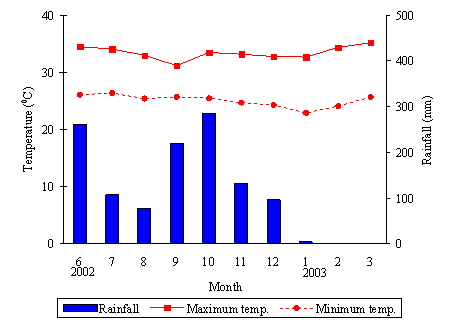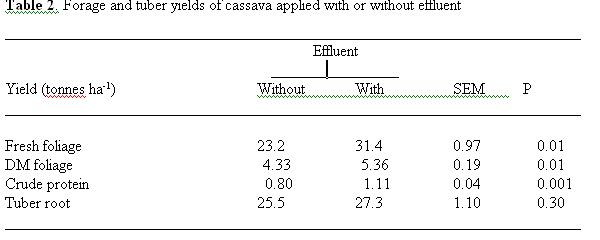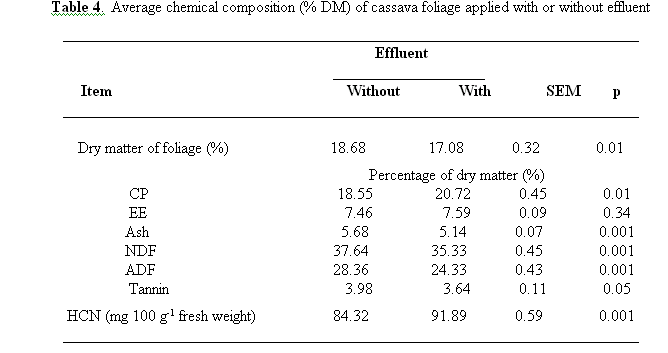Effect of effluent from low-cost plastic film biodigester on yield and chemical composition of cassava foliage and tuber yield
Duong Nguyen Khang and Thomas R
Preston*
Department of Animal
Physiology and Biochemistry,
Faculty of Animal Husbandry and Veterinary Medicine,
Nong Lam University, Vietnam.
duongnguyenkhang@yahoo.com
*University of Tropical
Agriculture Foundation, UTA - TOSOLY - Finca Ecológica,
Morario - Guapota - AA # 48, Socorro, Santander,
Santander del Sur, Colombia.
trpreston@mekarn.org
Abstract
A 4*2 randomized complete block design with 4 replications was conducted from June 2002 to March 2003 at the experimental farm of the Nong Lam University, Ho Chi Minh City, Vietnam, to determine effect of effluent from low-cost plastic film biodigester on yield of foliage and root tubers, and chemical composition of the foliage of cassava. Foliage of cassava of the variety KM 94, grown in plots of 10 m x 20 m at a planting distance of 30 cm x 50 cm, was hand-harvested according to respective treatments, starting 100 days after planting. All tubers were harvested at the final harvest 280 days after planting.
Mean dry
matter foliage yields were 5.36 and 4.33 tonnes per ha with or
without the effluent, respectively. The leaf dry matter proportion
was high, ranging from 60 to 66%. The proportion of leaf increased
and the stem decreased with application of the effluent.The CP production was 39% higher with the
effluent. The ADF and NDF
contents of foliage varied between 24.3 and 28.4%, and 35.3 and
37.6% of DM, respectively. The fresh tuber yield in the control
treatment was 25.5 tonnes per ha. The mean fresh weight of root
tubers was 7% higher with the effluent. It is therefore concluded
that the effluent from the biodigester could be used as fertilizer for foliage
production as well as tubers under these conditions.
Key words: biodigester, cassava,
foliage, effluent, tubers
Introduction
Economic evaluation studies have shown the importance of using
the digested effluent after the anaerobic digestion process, as well
as the biogas. The economic importance of the digested effluent is
becoming more acceptable in recent years in the developing
countries, and this concept is presented in many
publications of China, India and other countries. The effluent
discharged from a digester contains 1 - 12% solids and consists of
refractory organics, new cells formed during digestion, and ash.
The effluent can be used in its liquid or solid fractions, dried or
as total effluent. In most countries where biogas plants were
constructed, the effluent was used as a fertilizer. According to
studies in Sichuan province of China in year 1979, the nutrient
contents of the effluent increased yields by 6 - 10%, regardless of
kinds of soil. In long-term experiments, it was shown that the
chemical and physical properties of the soil were improved
markedly, after a few years of applying digester effluent, while
total yields of severa1 crops were 11- 20% higher than controls.
Cassava (Manihot esculenta Crantz), a tropical root crop widely cultivated in Vietnam, has great potential as a starch source for both human and animal consumption. The cassava plant also produces a lush crop of leaves, which are rich in protein, minerals and vitamins (Oomen and Grubben 1978) and are regarded as a good protein source (Lancaster and Brooks 1983). The crude protein content in cassava foliage ranges from 19 to 23% of dry matter (Khang and Wiktorsson 2000; Man and Wiktorsson 2001, 2002; Arvidsson and Sandberg 2003). Up to the present time, most of the experimental work reported has been focused on the production potential of cassava root for human and animal food, and only a few published reports have focused on cassava foliage production as a protein feed for livestock, together with tuber production (Hong et al 2003; Tung et al 2001; Khang et al 2004). However, the effects of effluent from biodigester on foliage and tuber yields and nutritive value of cassava foliage have not yet been fully investigated.
The objectives of this experiment were to determine
whether a high tuber yielding variety, KM 94, could yield
reasonable amounts of foliage as well as tubers under these
conditions.
Materials and methods
Location, land and climate
The study was conducted from June 2002 to March 2003 at the
experimental farm of Nong Lam University, Ho Chi Minh City,
Vietnam. The soil contained 54% sand, 39% silt, 7% clay, 0.62%
organic carbon, with 6.87, 76.21, 3.69, 1.13 and 0.13 meq per 100 g
of N, P, K, Ca and Mg, respectively, and a pH KCl of
5.79 at 15 cm depth (Soil Chemistry Lab. Data, Nong Lam University,
Ho Chi Minh City, Vietnam, 2002).
The climate in the area is a tropical monsoon, with the rainy
season between May and December and the dry season from February to
April. The monthly mean temperatures ranged from about 27.5
0C to 34 0C with minima in December and
February and maxima during the dry season. The mean relative
humidity was 76% (Figure 1).

Figure 1. Monthly rainfall and temperature at the time of
the experiment
The land was first cleared from weeds, and then ploughed by
tractor to a depth of 20 - 25 cm to loosen the soil. Weeds were
also removed twice during the establishment period.
Experimental design and treatments
Cassava was planted in monoculture for all the plots. The plots were each 10*20 m (200 m2) arranged in a randomized complete block design with 4 replications. Allocation of treatments is shown in Table 1. The experiment was set up in a field of 1940 m2, of which 1600 m2 was used for planting and 340 m2 was border area.
|
Table 1: The layout of the experiment |
||
|
Blocks |
Treatments |
|
|
1 2 3 4 |
C CS C CS |
CS C CS C |
|
C: Cassava without effluent; CS: Cassava with effluent |
||
Establishment and management
Cassava, variety KM 94, was planted early June 2002 and the
final harvest was 280 days after planting. Planting materials were
chosen from healthy and disease-free plants and cut into segments
just before planting. Cassava stem was planted in continuous rows
with 50 cm between rows, 30 cm between stem cuttings, and grown as
a pure stand. The length of stem was 20 - 25 cm. The planting depth
was 15 cm. Only effluent from a biodigester charged with cattle manure was applied
to the CS plots at 5 tonnes of DM per ha. The same rate of effluent was applied
after each harvest in these plots. No other fertilizers were
applied during the experimental period.
Harvesting and chemical analysis
The first harvest was made when the cassava plants reached 100
cm in height (about 100 days after planting). All the foliage was
cut at 30 cm above the ground. The same pattern was followed for
the re-growth at 60 days interval. Cassava foliage (comprising
young stems, leaves and petioles) was hand-harvested. Cassava
foliage was harvested between 08:00 h to 10:00 h to avoid HCN
fluctuation, which occurs later during the day due to the hot sun
(Yeoh and Oh 1979). Cassava tubers from all treatments were
harvested at the final harvest. All cassava foliage and tubers from
each plot were weighed to determine the fresh yield. The fresh
foliage was sampled and pooled from the 3 replicates (1.5 kg fresh
weight each), and was placed in a porous paper bag for dry matter
determination and chemical analyses. A similar sample was collected
to determine the ratio of leaf, petiole and stem to total foliage
on a DM basis. The contents of crude protein (CP), ether extract
(EE) and total ash in the samples were determined according to the
procedure of AOAC (1990). The contents of neutral detergent fiber
(NDF) and acid detergent fiber (ADF) were determined according to
the procedure of Van Soest et al (1991). Total condensed tannin
was determined by the butanol-HCl method (Terrill et al 1992).
The HCN content was determined by the alkaline titration method
(AOAC 1990).
Statistical analysis
Data were statistically analyzed using General Linear Model
Procedures of Minitab Statistical Software version 13.31. When the
F-test was significant (p < 0.05), the Tukey's tests for
paired comparisons was used to compare means. The relationship
between foliage yields or tuber yield, respectively, and cutting
intervals were determined using the linear or quadratic responses
in Fitted Line Plot procedure of Minitab 13.31.
Results
Effects of effluent from low-cost plastic film
biodigester on yield of foliage and tubers
Data on foliage and tuber yields of cassava for the whole period
of 280 days after planting are summarized in Table 2. Compared with the
control treatment, there was an average increase of 24% in total DM foliage
yield when the foliage was fertilized with the effluent from the biodigester.

Effects of effluent from low-cost
plastic film biodigester on fresh and dried proportions of
foliage
Fresh and dried weight proportions of cassava foliage applied
with or without effluent are presented in Table 3. Percent of leaf increased with the
effluent from
biodigester.
The results were the same for both fresh and dried weight
proportions of cassava foliage.

Effects of effluent from low-cost plastic film
biodigester on chemical composition of foliage
The analyses showed that CP content in cassava foliage varied from 18.6 to 20.7% of DM (Table 4).

The mean DM conten increased by 12% when the foliage was applied with effluent at 5 tonnes of DM per ha. The mean HCN content of fresh foliage increased, while the mean tannin and ash contents decreased with the effluent (Table 4). There were no differences in the content of ether extract.
Discussion
Dry matter yield of cassava foliage in the present study
increased from 4.3 to 5.4 tonnes per ha when cassava foliage
was fertilized with effluent at 5 tonnes DM per ha. The foliage yields were
slightly lower than the figures reported by Tung et al. (2001).
They conducted an experiment in which three cassava varieties (MM
92, Black Twig and Local) were grown for foliage yield estimation.
The results showed that dry foliage yields of MM 92, Black Twig and
Local cut at 45 day cutting intervals and about 15 cm harvesting
height over the 5 harvests were 5.9, 5.7 and 4.3 tonnes
ha-1, respectively. Thus, differences in DM foliage
yield could be due to the differences in variety (Gomez and
Valdivieso 1984; Simwambana et al 1992), fertilizer (Molina and
El-Sharkawy 1995), age at first cutting and interval between
cuttings (Lockard et al 1985; Simwambana et al 1992; Tung et al 2001; Hong et al 2003). Although there
are no data from
the present study on the effects of season on cassava foliage
yield, DM yield was reduced in all the treatments, strongly in the
control treatment during the last three months of the experimental
period, most likely due to the onset of the dry season.
The mean dry leaf proportion of the foliage was high (63%)
but with a wide range, from 60 to 66% (Table 3). The mean was
higher than found in an earlier study by Meyrelles at al (1977)
where the leaf proportion of cassava foliage on DM basis was almost
52% of shoot yield. The yield difference between varieties is
obvious, in addition to environmental and treatment factors. In the
present study, the dry leaf proportions were higher with applying
the effluent.
Crude protein content of cassava foliage ranged from 18.6 to
20.7% on DM basis in all treatments (Table 4). These results were
similar to the figure of 22.8% reported by Khang and Wiktorsson
(2000), and 18.8% reported by Man and Wiktorsson (2001). The
results showed that CP content on DM basis increased from 18.6 to
20.7% with applying the effluent from biodigester. Estimated protein
yield in the present study ranged from 0.8 to 1.11 tonnes per ha
with applying the effluent from biodigester during the growing period
of 280 days. This was lower than the levels of 1 to 1.5 tonnes per
ha with five cuts at 45 day interval for three cassava varieties
reported by Tung et al (2001).
Fibre components of cassava foliage varied from 35.3 to
37.6% of NDF and from 24.3 to 28.4% of ADF. Applying the effluent
decreased NDF and ADF contents. The levels of NDF and ADF were
equal to those found by Arvidsson and Sandberg (2003), but lower
than those reported by Man and Wiktorsson (2001, 2002). The
differences were probably due to differences in cassava variety,
study site and seasonal conditions.
Root yield was affected by the
effluent, with
a increase in tuber yield of 7% compared to the control treatment
without the effluent until 280 days after planting. A similar, but
less pronounced affect has been reported by Dahniya et al (1981)
with a high yielding cassava tuber variety. However, they only
picked the leaves from the top 30 cm of each branch at 1, 2, and 3
month intervals.
Conclusions
-
The effluent from biodigester strongly influenced the DM and CP yields of cassava foliage, the fresh weight of root tubers and to a less extent the nutritional quality of foliage produced during a growing season of 280 days.
-
The foliage DM , fresh weight of root tubers and CP yields were higher when the foliage was applied with effluent at 5 tonnes per ha.
-
It is concluded that effluent from the biodigester could be used effectively as fertilizer for foliage production as well as tubers under these conditions.
Acknowledgements
The authors are grateful to the Swedish International Development Cooperation Agency, Department for Research Cooperation (Sida/SAREC) for funding this study and Mr. Tuan and Mr. Thanh for their technical help.
References
AOAC 1990 Official methods of analysis of the Association of Official Analytical Chemists (15th Ed.), Washington, DC. 1: 69-90.
Arvidsson K and Sandberg J 2003 Cassava (Manihot esculanta Crantz) foliage: a crop by-product and potential protein feed for dairy cattle in Vietnam. MSc thesis. Swedish University of Agricultural Sciences, Uppsala, Sweden.
Dahniya M T Oputa C O and Hahn S K 1981 Effects of harvesting frequency on leaf and root yields of cassava. Expl. Agric. 17: 91-95.
Gomez G and Valdivieso M 1984 Cassava for animal feeding: effect of variety and plant age on production of leaves and roots. Anim. Feed Sci. Technol. 11: 49-55.
Hong N T T, Wanapat
M, Wachirapakorn, C Pakdee P and Rowlinson P 2003 Effects of timing of initial cutting and
subsequent cutting on yields and chemical compositions of cassava
hay and its supplementation on lactating dairy cows. Asian-Aus. J. Anim. Sci. 16: 1763 - 1769.
Khang D N and Wiktorsson
H 2000 Effects of cassava leaf
meal on the rumen environment of local yellow cattle fed
urea-treated paddy straw. Asian-Aus. J. Anim. Sci. 13:
1102-1108.
Khang D N, Wiktorsson
H and Preston T R 2004 Yield and
chemical composition of cassava foliage and tuber yield as
influenced by harvesting height and cutting interval. In: Cassava foliage as a protein source for cattle in Vietnam. Doctoral
thesis.
Lockard R G, Saqui M A and Wounuah D D 1985 Effects of time and frequency of leaf harvest on growth and yield of cassava (Manihot esculenta Crants) in Liberia. Field Crops Res. 12: 175-180.
Man N V and Wiktorsson
H 2001 Cassava tops ensiled with or
without molasses as additive effects on quality feed intake and
digestibility by heifers. Asian-Aus. J. Anim. Sci. 14:
624-630.
Man N V and Wiktorsson
H 2002 Effect of molasses on
nutritional quality of cassava and Gliricidia tops silage.
Asian-Aus. J. Anim. Sci. 15: 1294-1299.
Meyrelles L MacLeod N A and Preston T R 1977 Cassava forage as a source of protein: effect of population density and age of cutting. Trop. Anim. Prod. 2: 18-26.
Molina J L and El-Sharkawy M A 1995 Increasing crop production in cassava by fertilizing production of planting material. Field Crops Res. 44: 151-157.
Simwambana M S C, Ferguson T U and Osiru D S O 1992 The effects of time to first shoot removal on leaf vegetable quality in cassava (Manihot esculaenta Crants). J. Sci. Food Agric. 60: 319-325.
Terrill T H, Rowan A M Douglas G B and Barry T N 1992 Determination of extractable and bound condensed tannin concentrations in forage plants protein-concentrate meals and cereal grains. J. Sci. Food Agric. 58: 321-329.
Tung C M, Liang J
B, Tan S L, Ong H K and Jelan Z
A
2001 Foliage productivity and growth persistency of three local
cassava varieties. Asian-Aus J. Anim. Sci. 14:
1253-1259.
Van Soest P J, Robertson J B and Lewis B A 1991 Methods for dietary fiber neutral detergent fiber and non-starch polysaccharides in relation to animal nutrition. J. Dairy Sci. 74: 3583-3597.
Yeoh H H and Oh H Y 1979 Cyanide content of cassava Malayan Agri. J. 52: 24-28.